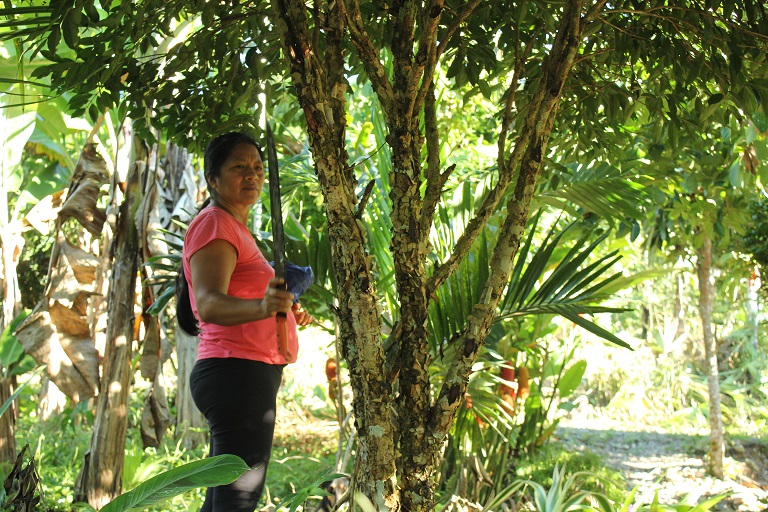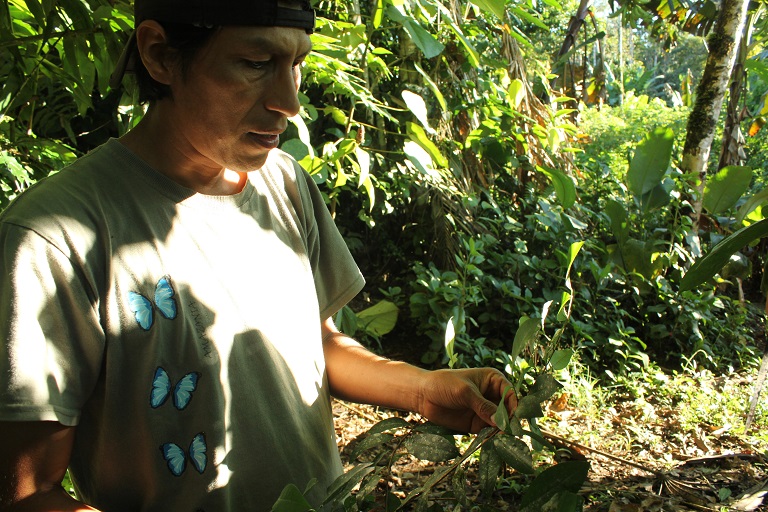- Though most cures are not medically proven and scientific experts remain skeptical of their benefits, others say that indigenous peoples’ long-accumulated wisdom of the forest and what grows in it is undeniable.
- In Ecuador, knowledge of the medicinal properties of the Amazon have been passed down throughout the generations by Yachaj, or medicine men, who spend years living with the forest, meditating and listening to nature.
- Training to become a Yachaj takes three to ten years and involves long separations from loved ones and society.
TENA, Ecuador – Benjamin Mamallacta Alvarado and his wife Dalia Tapuy Calapucha were both recently sick, but instead of going to a pharmacy to pick up medication, they went into their backyard, which just happens to be in the Amazon rainforest. Born and raised in the Amazon, Mamallacta has been using medicinal plants all his life from what is sometimes called “nature’s pharmacy.”
“You take out the essence of the leaf and mix it with lemon then put it directly into the nose, because here it will sting and attack the cold (virus),” Mamallacta said while preparing an elixir for his wife. Three different local plants are in this particular mixture: ginger from the Amazon (Costaceae) (a green leafy plant, different from the ginger found in supermarkets), Guayusa (Ilex guayusa) (a common plant used in teas as an energizer, or caffeine alternative), and Kalanchoe (Crassulaceae) or Chubriyuyu (as it’s known in the local indigenous Quichua language, and used for the common cold).

“You put it in the nose, you don’t drink it,” said Mamallacta. “Last week my wife had a strong cold, so we prepared this and she got better quickly.” He adds that you can also take the mixture twice a month to keep the body strong.
Mamallacta learned the healing powers of plants through his father, Casimiro Mamallacta el Kasike. He was a trained Yachaj, as it’s called in Quichua: a shaman or traditional healer. This knowledge has long been passed down through oral teachings from Yachajs who have spent years living with the forest, meditating and listening to nature.
But fending off the common cold is only one use of medicinal plants found in the Amazon.
In Mamallacta’s community of Tamia Yura, just a 10-minute drive from Ecuador’s Amazonian city of Tena, there are plants that can cure fever, bronchitis, diarrhea, stomach infections, colic, urinary tract infections, dengue, hair loss and even the initial stages of cancer, among other things, according to indigenous belief. Mamallacta and his wife are both indigenous Quichua, but similar plant usage can also be found among the Shuar, Achuar, Woarani, Sapara and other indigenous communities that live in the Amazon.
On a casual walk around his home, Mamallacta points out several plants in their Quichua names that carry medicinal powers. The leaf from the Kiwiyuyu (Acanthaceae), or the “leaf of sprains,” can cure sprains if ground into a paste and rubbed onto the injured body part. The Yawarpanga (Aristolochiaceae) is identified by the red tips on its large, green leaves and is used by women to regulate their menstruation. The little red flowers of the Shungo sisa (Bignoniaceae), or “tear of heart,” is used to improve blood circulation and treat heart conditions.

Very few of these remedies have been chemically studied, so many people are cynical about the real powers of medicinal plants, according to Cristina Penuela, biologist at the Regional Amazonian University (IKIAM) in Tena.
Penuela herself admits to being a bit skeptical about the plants’ proclaimed abilities, but also says that indigenous knowledge shouldn’t be taken for granted since it’s based on countless years of living in the rainforest.
“In general, people of the Amazon know plants,” she said. “It has been many millions of years that their local ancestors have been studying (plants)… and after trial and error, these societies were able to discern if a plant was antifungal, or serves some kind of purpose. There should be some respect for this accumulated knowledge.”
The wisdom of the Yachaj
The training to become a Yachaj, and developing your internal, mental and spiritual awareness is long and arduous. It can take anywhere from three to 10 years (depending on your community) of avoiding physical contact with your spouse, living on a strict diet (including no garlic or onions, whose smell is said to keep the spirits away), and living predominantly in the forest.
You also have to know how to take Ayahuasca, a powerful hallucinogenic made from two different plants found in the Amazon. It’s said that shamans get a lot of their spiritual power this way, as the visions that Ayahuasca produces can serve as an important awakening, a glimpse into the future or can heal emotional suffering — if guided properly.
A lot of medicinal plants are used to cleanse the body of illness or negative energies, with teas and steam baths being some of the more common treatments. According to biologist Penuela, a large part of traditional healing is mental and focuses on emotional wellbeing, which is why shamans, healers and the rituals they perform play an important role in the treatment.
This focus on overall wellbeing is perhaps where western medicine falls short, suggests Penuela. “A big problem with western medicine is that most medications are to momentarily alleviate a violence, or pain,” she said. “That’s not to say that western medicine hasn’t had advances, of course they have… but I think to integrally manage health, it’s not the west’s strength. They don’t ask integrally what is going on.”
According to Mamallacta, “spiritually and mentally, plants help.”
Risks to medicinal plants and indigenous culture
Medicinal plants are an important part of many Amazonian indigenous cultures and histories, but their use has dropped significantly over the years. According to researchers, a lot of this cultural change can be associated to the religious missionaries who arrived in the early part of the twentieth century.

According to Gabriela Zurita, an ethnologist at IKIAM, Protestant missionaries arrived in the Ecuadorian Amazon region in the 1940-1950s, at the same time oil was being discovered in the region. In contrast to the Jesuit missionaries who arrived decades earlier, the Protestants, along with the petroleum industry, hired local indigenous people, giving them a working wage for the first time. They also brought in outside products, including medicines. This drastically changed the cultural dynamic in the region.
The Protestants also strictly prohibited many indigenous traditions that they deemed ungodly — including medicinal plants, and especially Ayuhuasca, which they thought was demonic, according to Zurita.
Mamallacta’s father saw these changes first hand. He began training as a shaman as a child, but in his late teens and early twenties his priorities changed and he went to work for a group of missionaries in order to make money. He didn’t last long, however, and left the group after he saw how they were destroying the rainforest.
The missionaries have long been criticized for being a major driver of deforestation and displacing local indigenous populations. Zurita says that the link between the missionaries and the oil industry should not be overlooked.
“Many people criticize these missionaries, saying their objective was more to convince people to leave their territories in order to exploit for oil,” Zurita said. He added that it was likely this, rather than trying to introduce local indigenous cultures to religion.
In a 2009 research paper, “Oil Development, Deforestation, and Indigenous Populations in the Ecuadorian Amazon,” the authors argue that one of the main causes of deforestation in the twentieth century was actually an outcome of this “colonization.” Up to 240,888 hectares (595,247 acres) of rainforest was lost between the mid-1900s and 2000 to agricultural expansion, livestock and the creation of towns, driven by missionaries. In the same time period, 4,415 hectares (10,909 acres) were destroyed due to oil-related infrastructure and exploitation.
Despite these challenges, hundreds of indigenous communities continue to live across the Amazon region, and rely on medicinal plants. This includes Mamallacta and his family, many of whom have made it their life’s work to maintaining and growing this part of their culture.
“Forests need to be protected because inside them is our spirit, our medicines, our plants,” he said.
Banner image: Mamallacta picking a flower called Chiriwayusa in Quichua, which he will use for a medicinal steam bath. Photo by Kimberley Brown for Mongabay.
Kimberley Brown is a freelance journalist based in South America. You can find her on Twitter at @KimberleyJBrown.
FEEDBACK: Use this form to send a message to the author of this post. If you want to post a public comment, you can do that at the bottom of the page.
